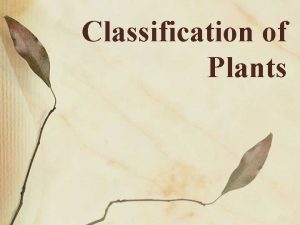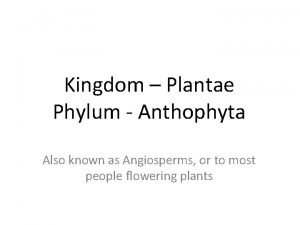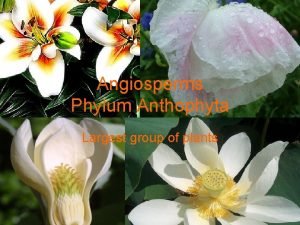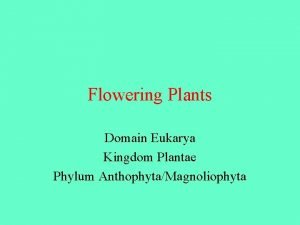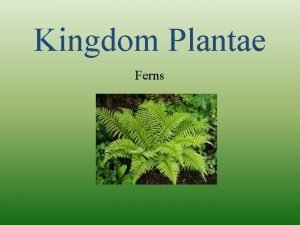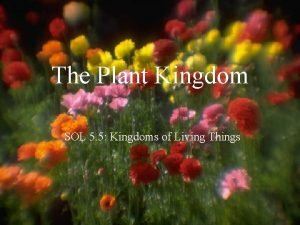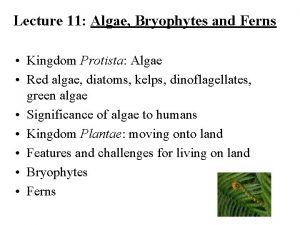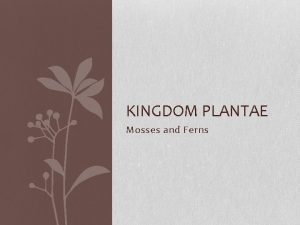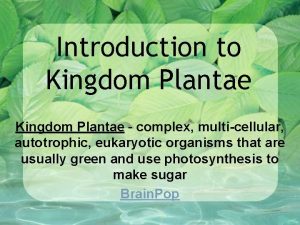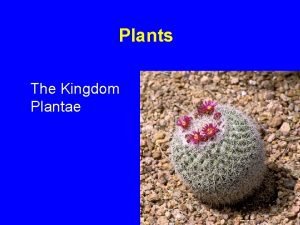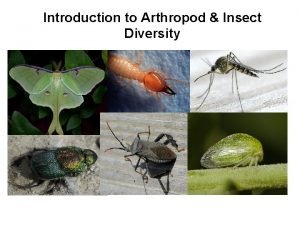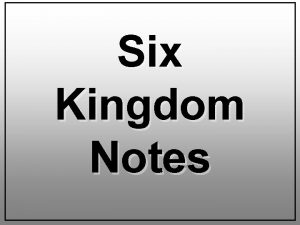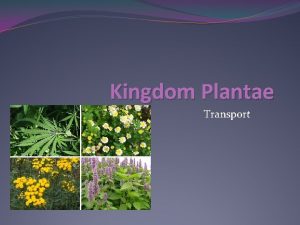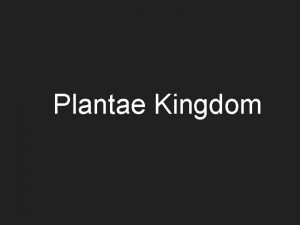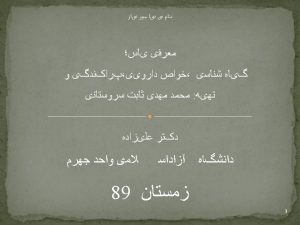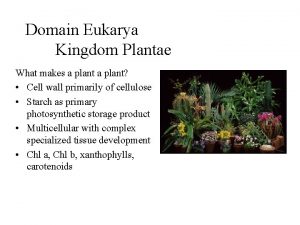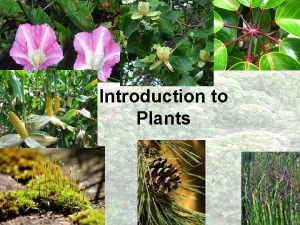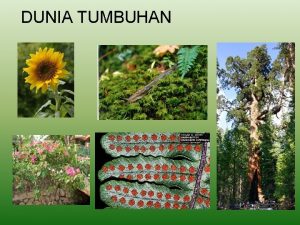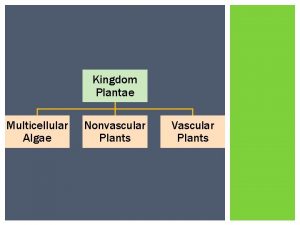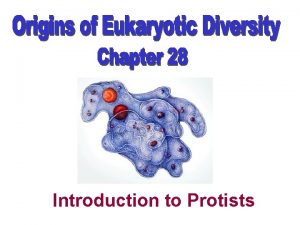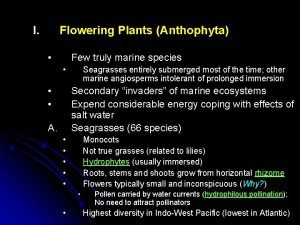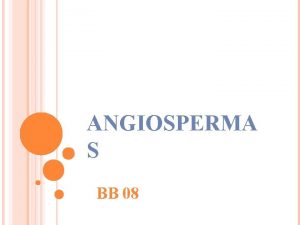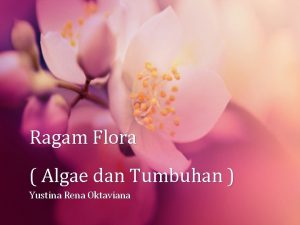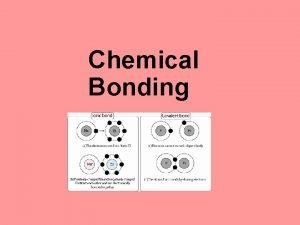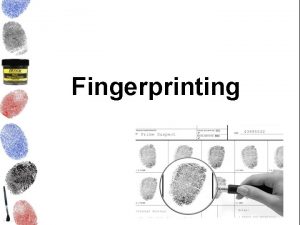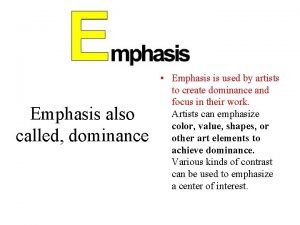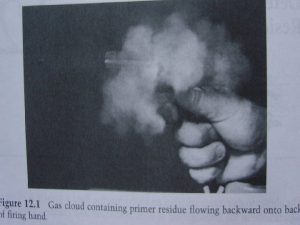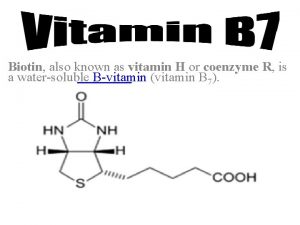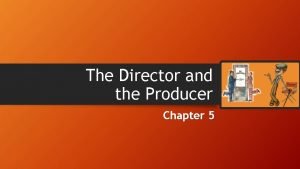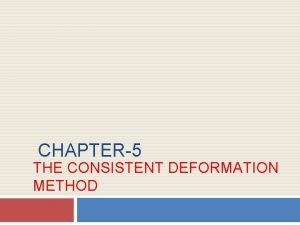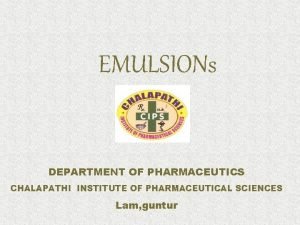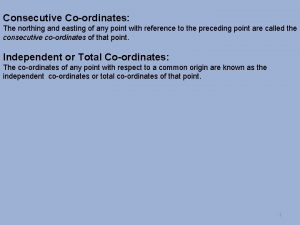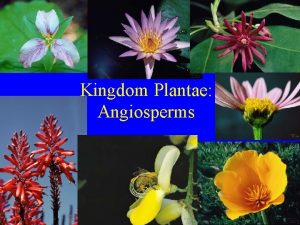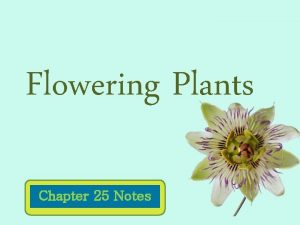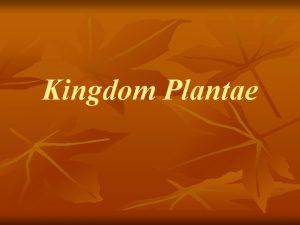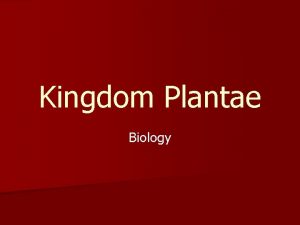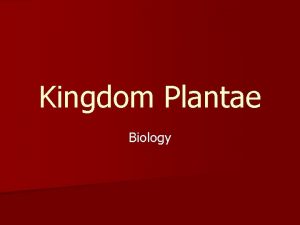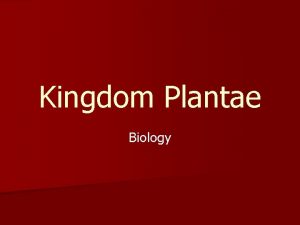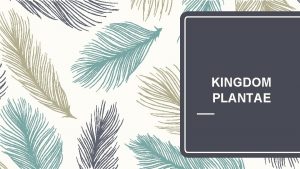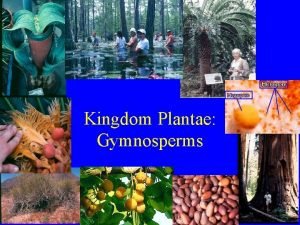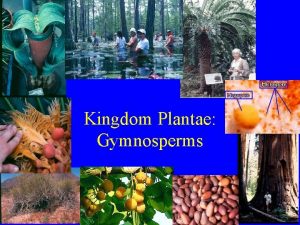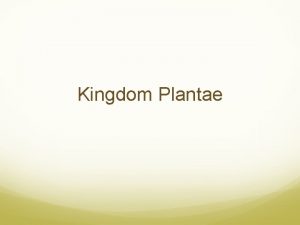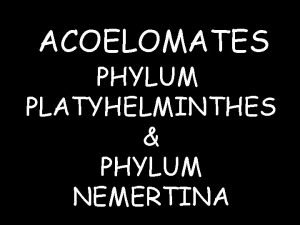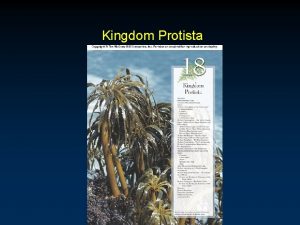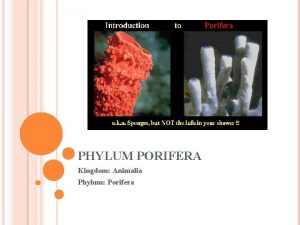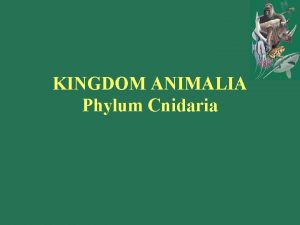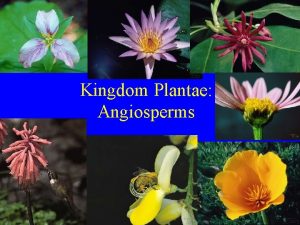Kingdom Plantae Phylum Anthophyta Also known as Angiosperms
























































- Slides: 56

Kingdom – Plantae Phylum - Anthophyta Also known as Angiosperms, or to most people flowering plants

Anthophyta - Angiosperms • Produce flowers and form seeds enclosed in fruit • Fruit protects the embryo inside the seed and aids in seed dispersal • Fruit develops from a flowers female reproductive structure



2 classes • Monocots (one seed leaf) Common monocots – corn, grass, lilly, and orchid • Dicots (2 seed leaves) Common dicots – Maple tree, tomatoes, potatoes, and dandelion


Can be divided by lifespans • Annuals (live for one year or less) Corn, beans, tomatoes, and many food crops • Biennials (lives for 2 years ) Parsley, carrots, Sweet William, raspberries • Perennials (can live for several years) Asparagus, hostas, roses, peonies, coreopsis and many others



Why flowers? • location for sexual reproduction in Angiosperms • co-evolved with the pollinators • symbiotic relationship – all species involved benefit!

Flower Anatomy • Many sizes, shapes and colors • Most contain the following organs in some shape or form • Petals • Sepals • Stamens • Pistols

Petals • Usually brightly colored • Often have perfume or nectar at the base • Provide surface for pollinators to rest on as they feed • All of the petals together are called the corolla

Sepals • Usually found in a ring at the base or outermost portion of the flower • Serve as protective covering for the flower bud • All of the sepals together are called the calyx

Stamen – male reproductive structure • Made up of the anther and filament • The anther is found at the tip of the filament – this is where pollen is produced • The number of stamens varies from flower to flower

Pistil/Carpel – female reproductive structure • Made up of the Stigma, Style and Ovary The stigma is at the top of the pistil. It’s role is to receive the pollen The style connects the stigma to the ovary The ovary is at the base. It contains ovules that produce eggs The number of ovaries in flowers


Complete vs Incomplete Flowers Perfect vs Imperfect Flower • Complete flowers: pistils, stamens, sepals and petals • Incomplete flower: lacking any of the parts • Perfect flower: has both pistils and stamens • Imperfect flower: lacks either pistils or stamens

Monoecious vs Dioecious • Monoecious –separate male and female flowers on the same plant • Ex. Corn, pecans, walnuts, cucumbers, and squash • Dioecious – separate male and female plants • Ex. Holly, ginkgo, pistachio, and marijuana

Photoperiodism • Photoperiodism: response of flowering plants to daily daylight-darkness conditions • Ensures all plants of the same species bloom at the same time

Critical Period • The specific daylight-darkness conditions that will make flowering begin • Day length is not what matters – amount of darkness is what matters • The names are misleading – the categories were named before scientists realized it was darkness, not light, that prompted flowering

4 Categories • Short-day: daylight is shorter than critical period – asters, poinsettias, strawberries • Long-day: daylight is longer than critical period – carnations, petunias, potatoes • Day neutral – flowers over a range of daylight hours, day length is not what induces flowering • Intermediate day – will not flower if days are longer or shorter than critical period – sugarcane and grass


Pollination & Fertilization Aka – the birds and the bees

Development of the female gametophyte • Inside the flower the sporophyte produces haploid spores • Female spores are megaspores • The nucleus of the megaspore undergoes mitosis 3 times to produce the female gametophyte • One nucleus becomes the egg, another two become the central cell.


All of this is taking place inside the ovaries, which are part of the pistil.

Development of the male gametophyte…so much simpler than the female • Microspores are produced inside the anther • Microspores develop into the male gametophyte – the pollen grain • The haploid nucleus undergoes mitosis, but only once • One nucleus is the tube nucleus, the other is the generative nucleus


Now that we have sperm and eggs, how do we get them together? • POLLINATION! • Definition – the transfer of the pollen grain from the anther to the stigma • Possible pollinators – wind, water and animals

Adaptations in flowers Some features that attract animals – Strong scent – Nectar – Bright colors – Patterns invisible to the human eye

Adaptations in wind pollinated plants • Lack of petals – no need to waste energy attracting the wind • Overproduction of pollen – to make up for the pollen that never makes it to the stigma

The pollen grain has landed on the stigma, so what’s next? Double Fertilization!!


Seed Germination & Vegetative Reproduction


Seed germination • Dormancy – the period of inactivity in a mature seed • Varies greatly between species • Ends when the seed germinates • Germination – the beginning of the development of the embryo into a new plant

Germination • Water, oxygen and warm temperatures activate the metabolism • Some seeds have specific requirements – Ex. Animals digestive system, freezing temps, extensive soaking in saltwater, specific daylengths, exposure to fire.

Dicot germination • Radicle – embryonic root appears first • Hypocotyl – portion of stem nearest seed • Cotyledon – plants first leaves • In monocots the cotyledon remains below the surface



Vegetative reproduction • A new plant is produced from a stem, root or leaf • This is essentially cloning – producing new plants that are genetically identical to their parents • Tissue culture and/or cuttings.

Chapter 24. 3 Seeds and Fruit

Why? • The seeds and fruits formed help ensure survival of the next generation

Seed formation • After fertilization • Zygote divides = embryo • Triploid cell divides = endosperm • Ovule wall = seed coat

Fruit formation • Fruit – the structure that contains the seeds of an anthophyte • Fruit – the enlarged ovary surrounding the seed • Can be made up of other organs as well.


Fruits • Fleshy fruits – apples, grapes, melons, tomatoes, cucumbers • Dry fruits – peanuts, sunflower seeds, walnuts. –The ovary around the seeds hardens

Seed dispersal • Fruits aid in dispersal • Dispersal reduces competition • Animals – digestion and/or carrying the seed on the body • Wind – dandelion, tumbleweed • Water – coconut and water lilies

Pictures – from flower to fruit • http: //www. cas. vanderbilt. edu/bioimages/pa ges/fruit-devel. htm


What about seedless fruit? • Ex. Watermelon and bananas • Triploid plants – prevents meiosis from happening and no gametes are produced • So where do the plants come from if there are no viable seeds?

• Bananas – vegetative reproduction • Watermelons – Cross a diploid with a tetraploid to produce a triploid seed • Diploid (2) + Tetraploid (4) = 6 sets of chromosomes • Divide 6 by meiosis to get 3 sets of chromosomes. • Pollination triggers fruit formation – without seeds. • The plants must be grown with a diploid variety for pollen

Seed germination • Dormancy – the period of inactivity in a mature seed • Varies greatly between species • Ends when the seed germinates • Germination – the beginning of the development of the embryo into a new plant

Germination • Water – activates the metabolism • Some seeds have specific requirements –Ex. Animals digestive system, freezing temps, extensive soaking in saltwater, specific daylengths, exposure to fire.

Dicot germination • Radicle – embryonic root appears first • Hypocotyl – portion of stem nearest seed • Cotyledon – plants first leaves • In monocots the cotyledon remains below the surface

Vegetative reproduction • A new plant is produced from a stem, root or leaf • This is essentially cloning – producing new plants that are genetically identical to their parents • Tissue culture and/or cuttings.
 Kingdom plantae characteristics
Kingdom plantae characteristics Kingdom protista
Kingdom protista Similarities between protists and fungi
Similarities between protists and fungi Coniferophyta life cycle
Coniferophyta life cycle Anthophyta reproduction
Anthophyta reproduction Botão floral
Botão floral Roman empire
Roman empire Capital of egypt during the old kingdom
Capital of egypt during the old kingdom Old kingdom middle kingdom new kingdom
Old kingdom middle kingdom new kingdom Nnn ruled
Nnn ruled Eukarya plantae
Eukarya plantae Kingdom plantae vascular and nonvascular
Kingdom plantae vascular and nonvascular Diagram of kingdom plantae
Diagram of kingdom plantae Benefits of algae
Benefits of algae Characteristics of ferns and mosses
Characteristics of ferns and mosses Plantae mobility
Plantae mobility Which kingdom is autotrophic
Which kingdom is autotrophic A multicellular autotrophic organism with vascular tissue
A multicellular autotrophic organism with vascular tissue Are all plants multicellular
Are all plants multicellular Nonvascular plants
Nonvascular plants Animal kingdom cladogram
Animal kingdom cladogram Plant character
Plant character Kingdom plantae chart
Kingdom plantae chart Archaebacteria body form
Archaebacteria body form How do plantae get nutrients
How do plantae get nutrients Protista chart
Protista chart Which organisms are in the phylum tracheobionta
Which organisms are in the phylum tracheobionta Kingdom plantae domain
Kingdom plantae domain Plantae kingdom
Plantae kingdom Siklus hidup tumbuhan paku
Siklus hidup tumbuhan paku Kingdom animalia eukaryotic or prokaryotic
Kingdom animalia eukaryotic or prokaryotic Crash course taxonomy
Crash course taxonomy Multicellular algae kingdom
Multicellular algae kingdom Kingdom plantae
Kingdom plantae Monera, protista, fungi, plantae animalia
Monera, protista, fungi, plantae animalia Surf grass phylum
Surf grass phylum Filo anthophyta
Filo anthophyta Tumbuhan biji tertutup disebut anthophyta karena
Tumbuhan biji tertutup disebut anthophyta karena Also known as electron pooling
Also known as electron pooling Different method of size separation are
Different method of size separation are Laminated dough
Laminated dough Wide shot camera angle
Wide shot camera angle Aims of secondary education
Aims of secondary education Study of fingerprints for identification
Study of fingerprints for identification Emphasis by placement in art
Emphasis by placement in art Molten paraffin
Molten paraffin Vitamin h is also known as
Vitamin h is also known as Two digit counting number that looks the same upside down
Two digit counting number that looks the same upside down The text-based director, also known as the
The text-based director, also known as the Cutline caption example
Cutline caption example Consistent deformation method for beams examples
Consistent deformation method for beams examples Bench terrace sloping inward also known as
Bench terrace sloping inward also known as Holi is also known as
Holi is also known as Motherboard circuit board
Motherboard circuit board Creaming test for emulsion
Creaming test for emulsion Stock
Stock Consecutive coordinates in surveying
Consecutive coordinates in surveying



